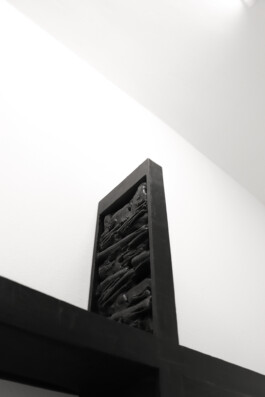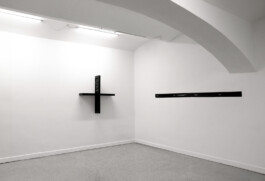UGLY SCENES. NUANCES

In the series of works Ugly Scenes. Nuances, I engage with the philosophical inquiries of Gilles Deleuze, exploring the concepts of layering, differentiation, repetition, vibration, and the multilayered nature of reality, where processuality and oscillations are the fundamental principles of existence. Contrasts, as an inseparable part of the historical process, structure perception, and my work is aimed at contemplating these oppositions within the context of rigid philosophical and social constructs. Within this framework, I adhere to the theory of "punitive restraint" (Foucault), where concealing the emotional component, seemingly cut by anxiety, becomes an act of control over perception and an attempt to focus on intellectual analysis.
The theme of unrealized utopias and thinking in terms of totality is deeply integrated into my work, hidden in the carved details on wooden surfaces, absorbed by black pigment, which symbolizes both absorption and the absence of light. I continue to develop the idea of the repetition of violence in history, emphasizing the processes of systematization, classification, and ordering of events. These processes, in essence, create a distance between us and the emotional response to the tragic episodes of our time, turning them into abstraction and statistics. My visual narrative draws inspiration from religious symbolism, often used in sacred art, and the strict conventions of minimalism. The fragile vertical lines of the works contrast with contextual elements, creating tension between form and content. Modernity, immersed in anxiety and catastrophization, demands organization, even in the most chaotic reality.
My approach also intersects with the concept of the "world as a dynamic structure" by Deleuze, where recurring forms and processes possess their own internal logic and movement. I continue to use suggestive visual methods, deliberately concealing the emotional component behind a rigid minimalist form. This forces the viewer to closely search for the hidden meaning, immersing them in a process of reflection and interpretation. Particular attention in the works is given to elements of bone deterioration, a symbol of the confrontation between physical form and human vulnerability, both physically and mentally. Bone erosion serves as a metaphor for inevitable mortality and reflects the eternal clash between decay and renewal. Here, a dichotomy arises: decay gives meaning to life and simultaneously provokes anxiety. Bone is the foundation of the human body, its core, but disorganized bone deterioration destroys this stability, reminding us of the fragility of existence. However, destruction is not an end, but a movement—the decay of the old opens space for the new.
Additionally, I use elements visually similar to the works of artist Hans Schwarz, particularly his piece Death and the Maiden, to create a dialogue that highlights issues that still concern us all, with a 500-year gap. This allows the modern viewer to reconsider timeless themes, despite cultural and historical differences. Aesthetic visualization of violent scenes in different eras traditionally carried a cathartic function, conditioned by eschatological consciousness and collective fears. When encountering images of violence, we face a whole spectrum of emotions that have a "cleansing" effect. This phenomenon can be observed in the Renaissance and Baroque periods, where the tragedy of the individual served as a metaphor for the tragedy of the world. In my works, this interconnection is also evident, linking personal and global tragedy through the language of art.

Ugly scenes. Nuances 4.1., 100 × 100 × 5 cm (x2), black wood, linseed oil, beeswax, 2025. Close-up


Installation view of the exhibition Light bent backward, waiting to be forgotten, arka arka, Vienna, AT, 2025

Ugly scenes. Nuances 4.1., 100 × 100 × 5 cm (x2), black wood, linseed oil, beeswax, 2025. Close-up